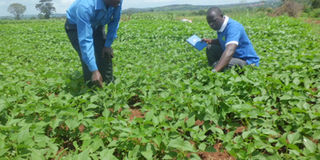With a growing population, we need crop intensification – survey

Researchers collect data during a field trial. With an increasing population, there is a need for farmers to intensify their crop production per unit of land backed by research and policy. FILE PHOTO
A socio-economic survey has shown the need for farmers as well as policy makers to make use of research to enhance crop intensification.
While it helps the former boost productivity, it provides the latter with evidence to identify the constraints at individual, household, community, market, and policy levels.
The survey was carried out by Action for Sustainable Intensification for Cropping Systems in Uganda (Pasic) in two regions; South Western Highlands (Kabale, Kisoro and Kanungu)—known for Irish potato production, and the Kyoga plains (Tororo, Bugiri and Butaleja)—known for rice production.
Outcome indicator
“We sought to determine the drivers of crop intensification, whether intensification improves production and productivity, and whether intensification affects well-being among the rice and Irish potato farmers,” Dr Pamela Pali, project co-coordinator, Pasic, explains.
“A main outcome indicators for crop intensification is productivity, defined as amount of the crop harvested per unit of land. In our case, we looked at the amount harvested per acre. We disaggregated along two factors: Crop, which has two levels (rice and potatoes) and season, which has two levels (first and second).”
The data collection was conducted using direct structured interviews with the farmers.
Working with partners
A total of 902 participated in the surveys. Purposive sampling including only potatoes and rice farmers was used initially after which a random sample of 405 households in the east and 497 in the south west was generated.
There were 172, 103 and 130 farmers in the survey from Tororo, Butaleja and Bugiri districts respectively. And 257, 157 and 83 farmers from Kabale, Kisoro and Kanungu districts. In all, 71 enumeration areas were sampled.
For the survey, Pasic collaborated with various partners; Ministry of Agriculture, Animal Industry and Fisheries (Maaif), Economic Policy Research Centre (EPRC), International Institute for Tropical Agriculture (IITA) and International Food Policy Research Institute (IFPRI).
The findings are in a report, Crop Intensification in Rice and Potato Farming in Uganda: Description of the Socio- Economic Data.
In the south west, the land holdings are parcelled into smaller units—on average, 0.6 acres—while in the east, it is 1.3 acres on average. This clearly suggests that there much more land fragmentation in the former.
For rice, land is often rented. This suggests a higher degree of commercialisation. However, most farmers do not have a written statement of their use rights.
The report adds that “almost 50 percent of parcels in the east have use right restrictions, as opposed to only 16 per cent of the parcels reported by potato farmers.”
Scope for action
There is high market participation for both potatoes and rice. For potato, 71 per cent of households reported sales. For rice, it was 95 per cent of the households who reported sales.
Most of the sales, however, occur immediately after the harvest. This is the worst possible time to obtain favorable prices for produce. Thus, this finding presents substantial scope for policy action.
“Our farmers need to know that they should not stop at producing these crops alone but also ensure value addition. This is because they lose a lot if they do not add value to their products,” says Dr Swaibu Mbowa, senior researcher, EPRC.
“The output of these researches are made available to farmers so as to enhance their knowledge on crop production.”
Collective learning
The findings play an important role in the collective learning activities while also ensuring that the evidence brought into these learning efforts is used in an appropriate manner.
Dr Mbowa says the background information on policy will be used to analyse policies that hinder crop intensification.
As a partner involved, Maaif will formulate policies after enabling evidence has been generated to foster collective learning.
EPRC contributes on policy studies and value chain analysis by providing knowledge of the policy environment in the agricultural sector and in building capacity at the ministry.
Feeding the people
In the value chain analysis, it has developed tools for data collection, pretested them, had an internal review of the tools from partners, finalised with the tools and trained enumerators.
These will be in the field to carry out research analysis in the two zones that comprise six districts in total.
The interesting part about the study is that it started with IFPRI doing social economic studies then IITA doing the agronomic studies. EPRC will be doing the community survey.
As Uganda’s population is growing and the demand of food is increasing too. “The only way out for feeding the growing population is through crop intensification since land is limited and does not increase or expand,” he says.




